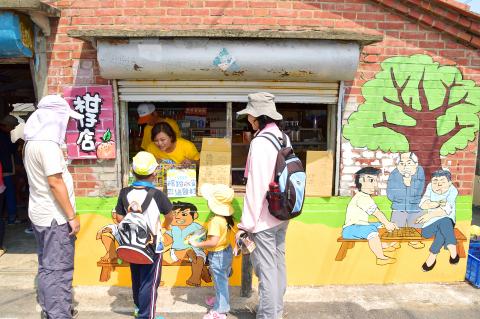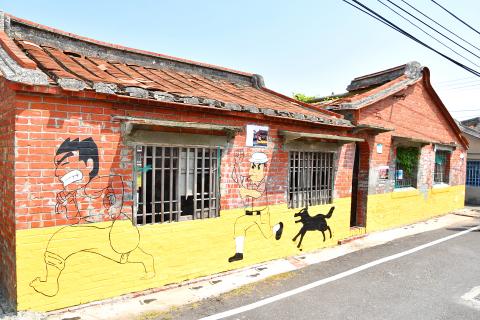Kaohsiung’s Yongan District Office (永安) and a local non-governmental organization (NGO) have invited students and staff from the Tungfang Design Institute to help decorate old houses in the city’s Yantian Borough (鹽田) to promote the former salt- producing community as a cultural tourism destination.
Houses on Sinsing Street (新興街) have been painted with murals depicting scenes from the township’s bygone days of salt manufacturing, such as workers laboring on the salt pans and police chasing salt thieves.
Netizens have praised the work, calling Yantian “Taiwan’s most dreamy salt village.”

Photo: Su Fu-nan, Taipei Times
Yongan District Administrator Ling Wen-chi (林文祺) said that the borough’s old-fashioned red-brick houses and their saddle-shaped roofs are particularly appealing to tourists.
According to Yantian Borough Warden Huang Fu-lai (黃福來), the township’s first residents came from Tainan’s Beimen District (北門) en masse to work on the salt pans.
At the economic height of Yantian, which means “salt pan,” 3,000 residents lived and worked in the township, which had houses for salt workers, a town commissary, library, kindergarten, barber shops and an infirmary, Huang said.

Photo: Su Fu-nan, Taipei Times
About 30 years ago, Taiwan Power Co bought the salt pans from Taiwan Salt Co to build the Hsinta Power Plant, closing the once lively salt town in the process, Huang said, adding that with their livelihoods gone, the townspeople moved out, leaving just over 100 people in the community.
A cultural tourism event titled “Colorful Yongan: Coloring Salt Village” was jointly held by the Yantian District Office and Yantian Township Development Association — a local NGO — on Sunday, which drew a large crowd.
Visitors queued to visit the township’s last running gamadiam (柑仔店) — the Hoklo (commonly known as Taiwanese) word for an old-fashioned corner store.
Yantian resident Wu Jung-cheng (吳榮正), 60, said the gamadiam has been open since his childhood and “represents a cherished shared memory to all of Yantian’s residents.”
As a part of its cultural tourism program, the district office has also prepared the Salt Village Artifacts Exhibition and visitors who want to see for themselves what work on the salt pans was really like can try their hand pushing around salt carts laden with a worker’s average load.

Trips for more than 100,000 international and domestic air travelers could be disrupted as China launches a military exercise around Taiwan today, Taiwan’s Civil Aviation Administration (CAA) said yesterday. The exercise could affect nearly 900 flights scheduled to enter the Taipei Flight Information Region (FIR) during the exercise window, it added. A notice issued by the Chinese Civil Aviation Administration showed there would be seven temporary zones around the Taiwan Strait which would be used for live-fire exercises, lasting from 8am to 6pm today. All aircraft are prohibited from entering during exercise, it says. Taipei FIR has 14 international air routes and

Taiwan lacks effective and cost-efficient armaments to intercept rockets, making the planned “T-Dome” interception system necessary, two experts said on Tuesday. The concerns were raised after China’s military fired two waves of rockets during live-fire drills around Taiwan on Tuesday, part of two-day exercises code-named “Justice Mission 2025.” The first wave involved 17 rockets launched at 9am from Pingtan in China’s Fujian Province, according to Lieutenant General Hsieh Jih-sheng (謝日升) of the Office of the Deputy Chief of the General Staff for Intelligence at the Ministry of National Defense. Those rockets landed 70 nautical miles (129.6km) northeast of Keelung without flying over Taiwan,

City buses in Taipei and New Taipei City, as well as the Taipei MRT, would on Saturday begin accepting QR code payments from five electronic payment providers, the Taipei Department of Transportation said yesterday. The new option would allow passengers to use the “transportation QR code” feature from EasyWallet, iPass Money, iCash Pay, Jkopay or PXPay Plus. Passengers should open their preferred electronic payment app, select the “transportation code” — not the regular payment code — unlock it, and scan the code at ticket readers or gates, General Planning Division Director-General Liu Kuo-chu (劉國著) said. People should move through the

The Ministry of National Defense (MND) today released images of the military tracking China’s People's Liberation Army (PLA) movements during the latest round of Chinese drills around Taiwan. The PLA began "Justice Mission 2025" drills today, carrying out live-fire drills, simulated strikes on land and maritime targets, and exercises to blockade the nation's main ports. The exercises are to continue tomorrow, with the PLA announcing sea and air space restrictions for five zones around Taiwan for 10 hours starting from 8:30am. The ministry today released images showing a Chinese J-16 fighter jet tracked by a F-16V Block 20 jet and the